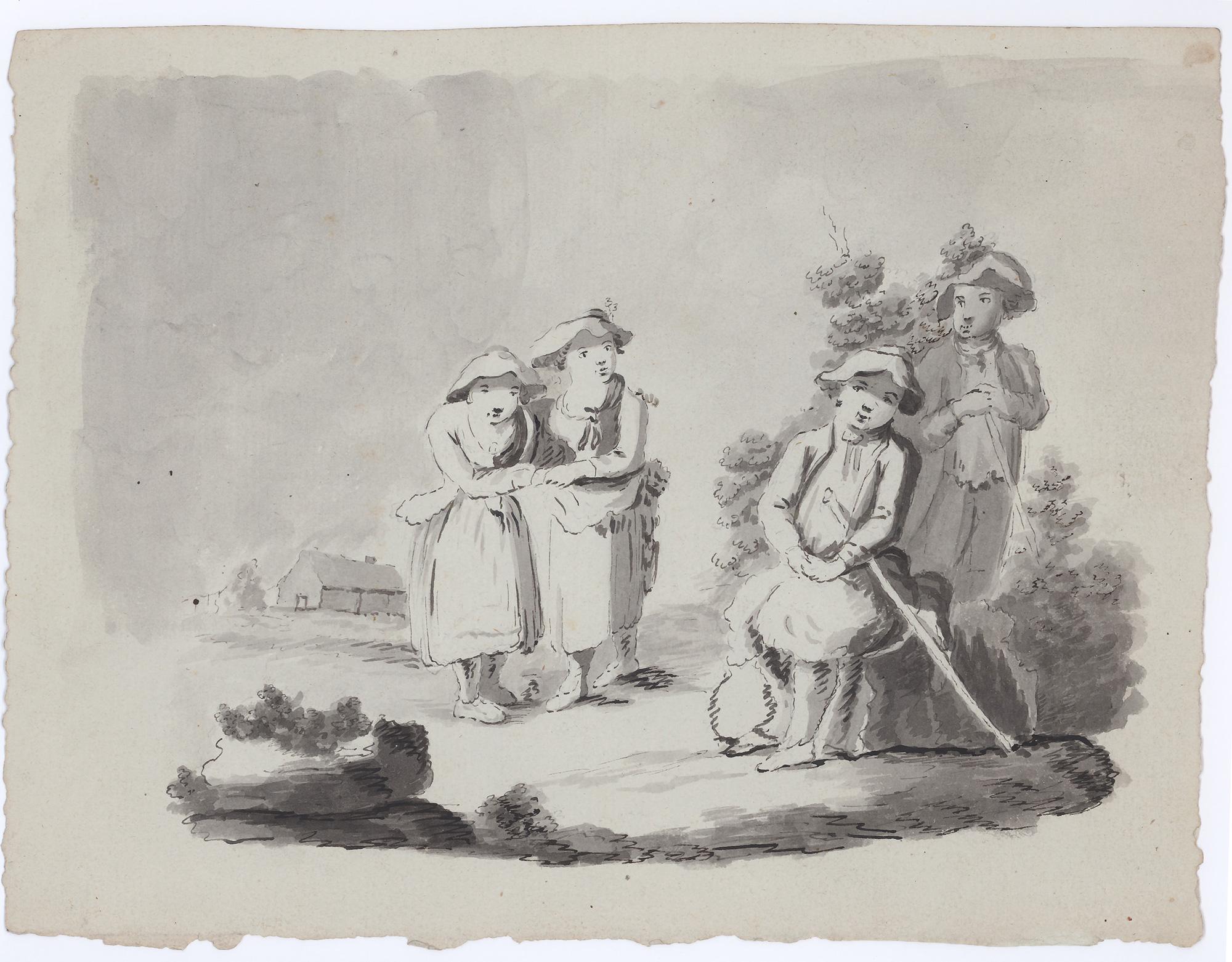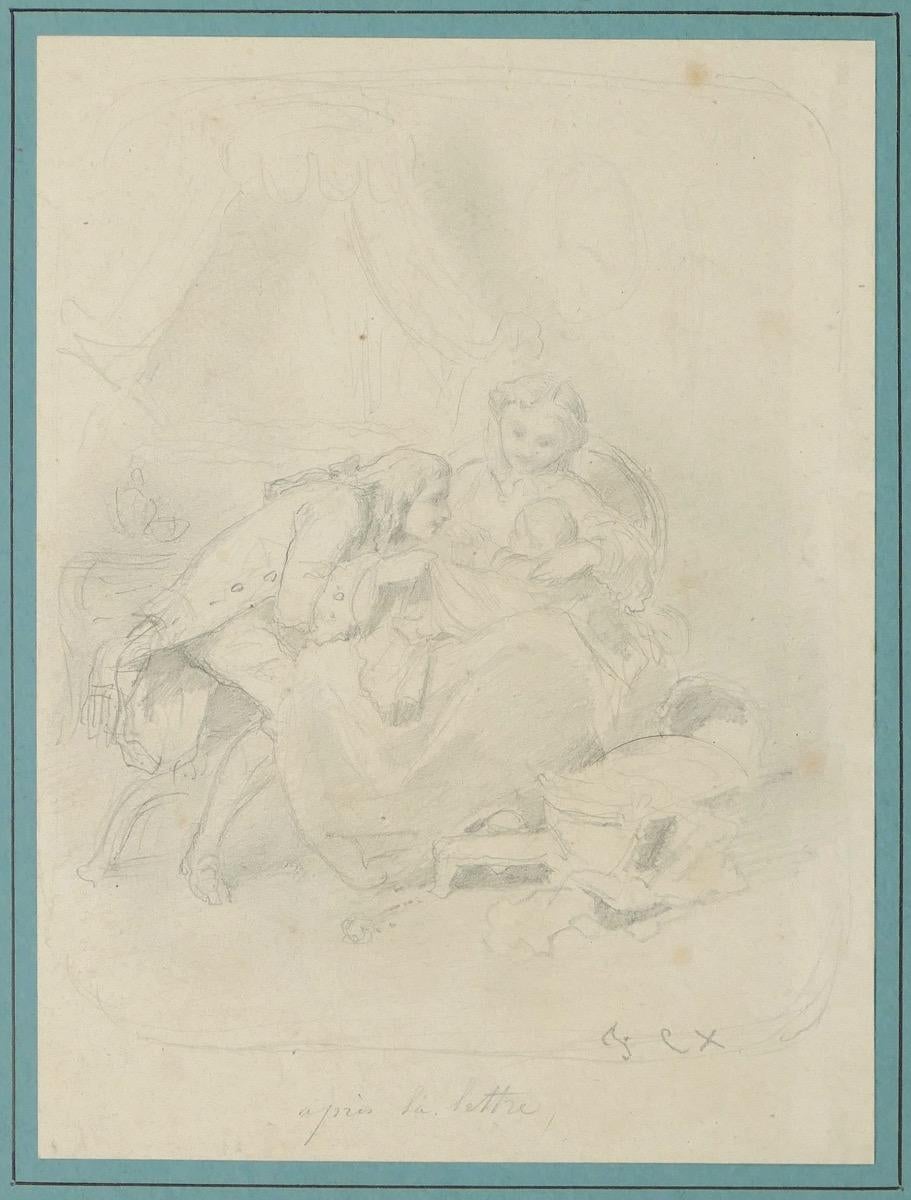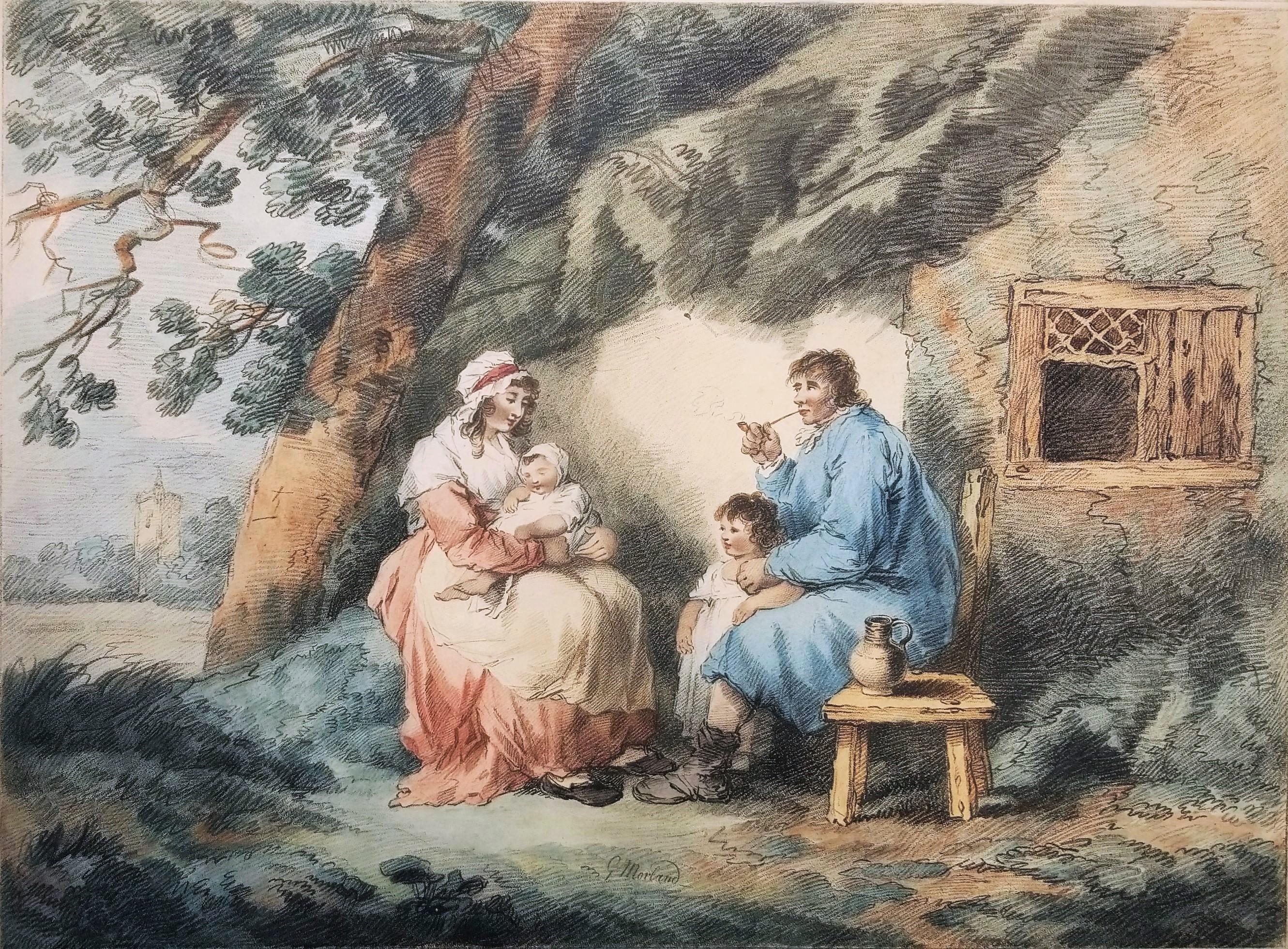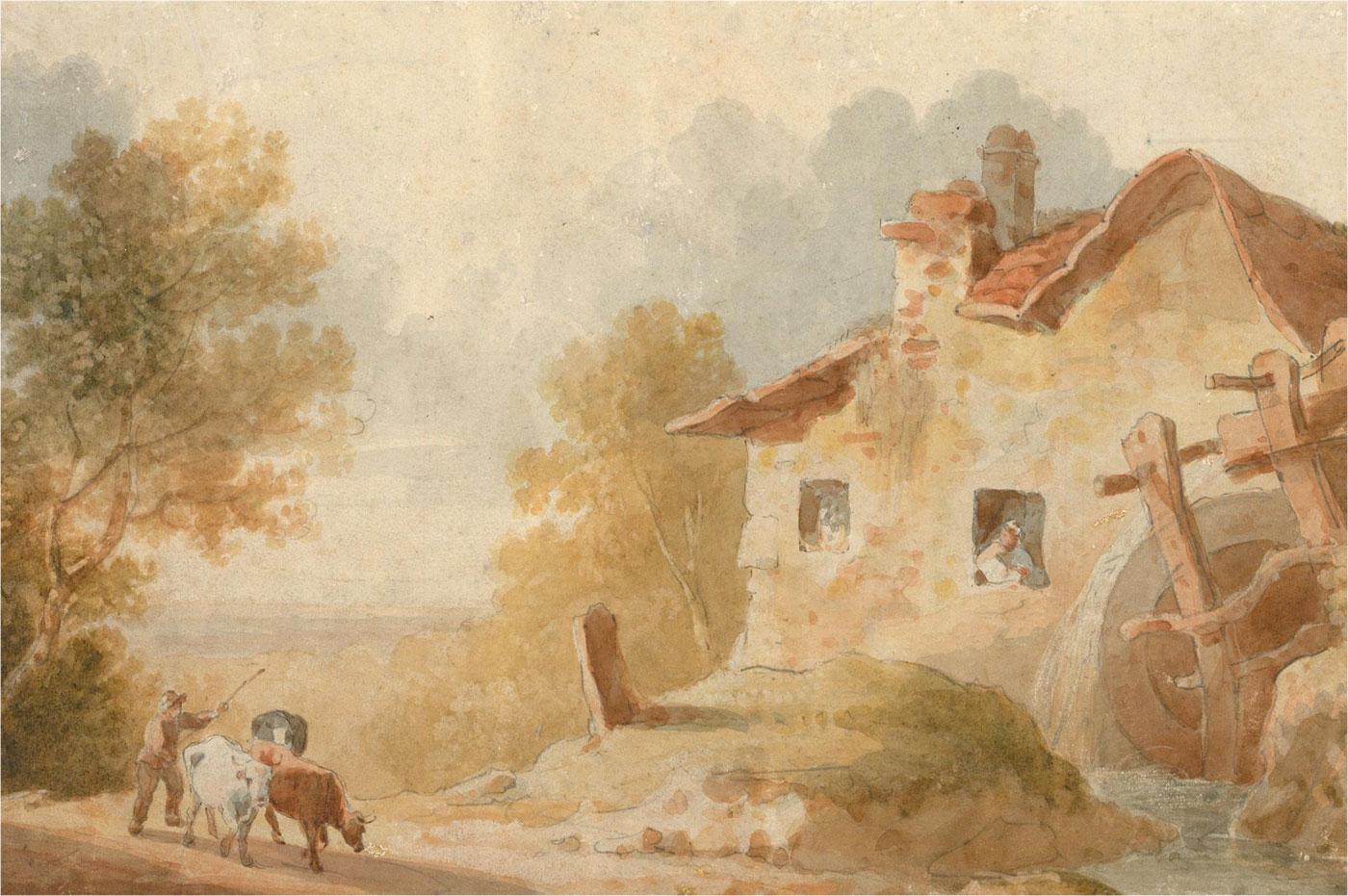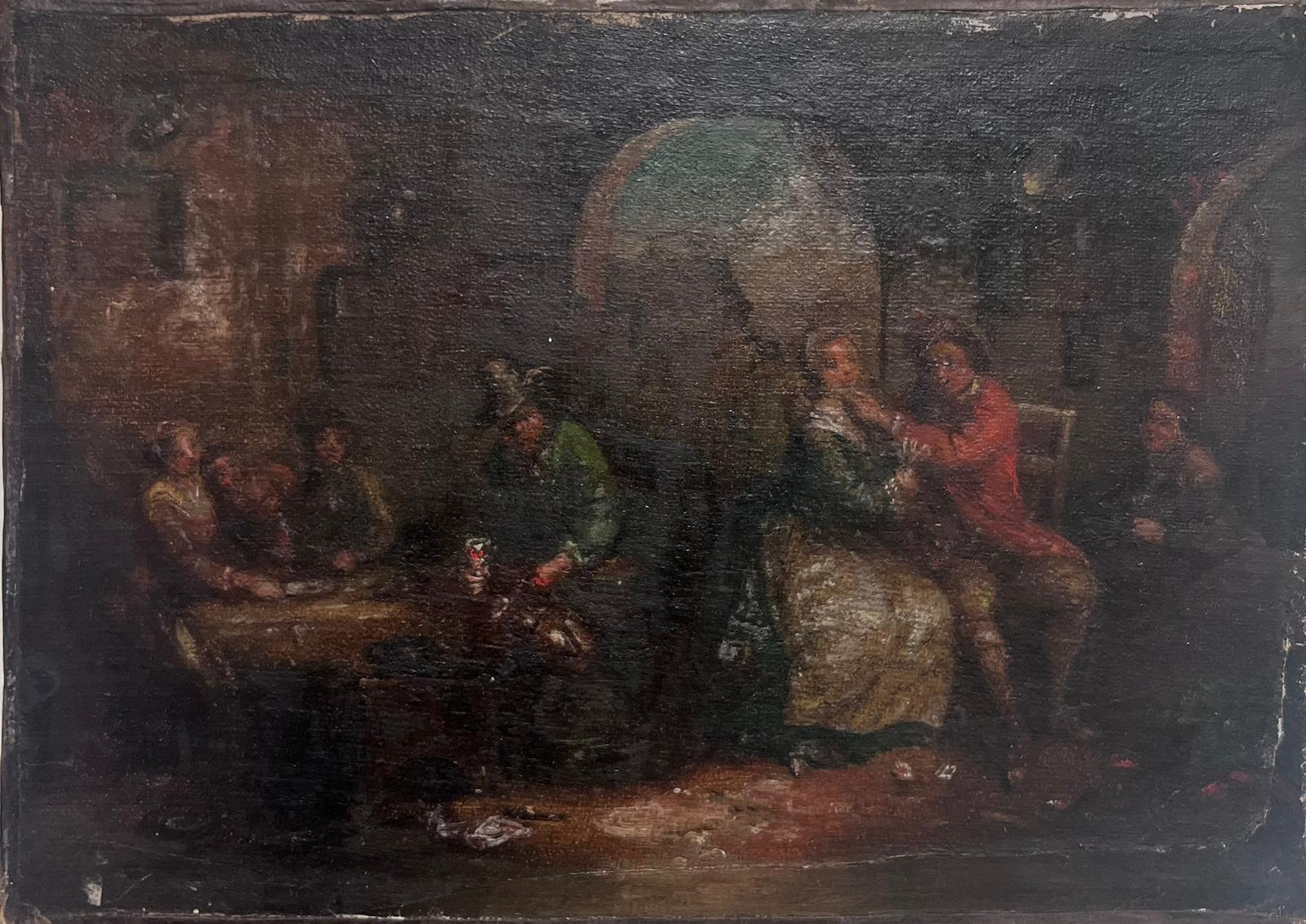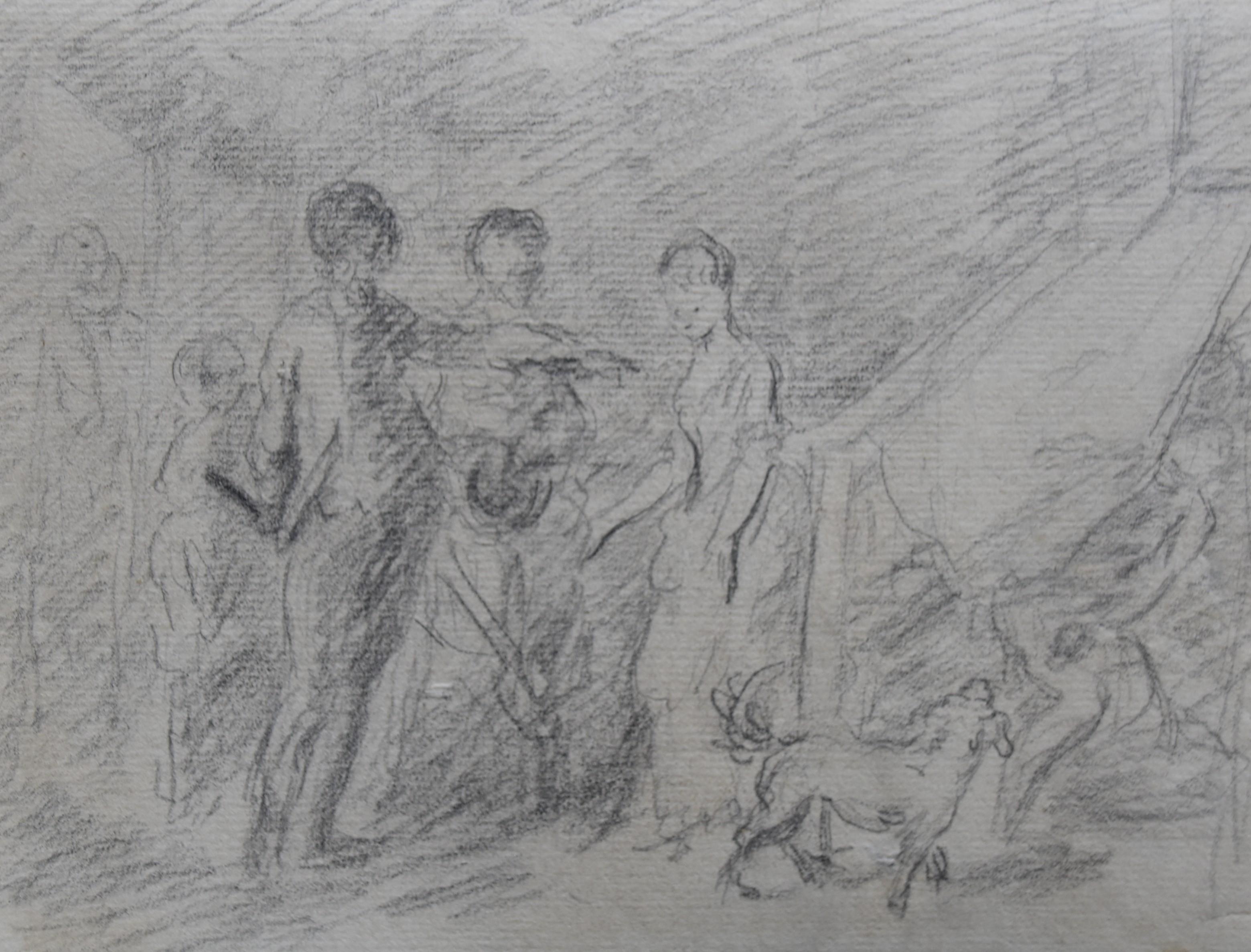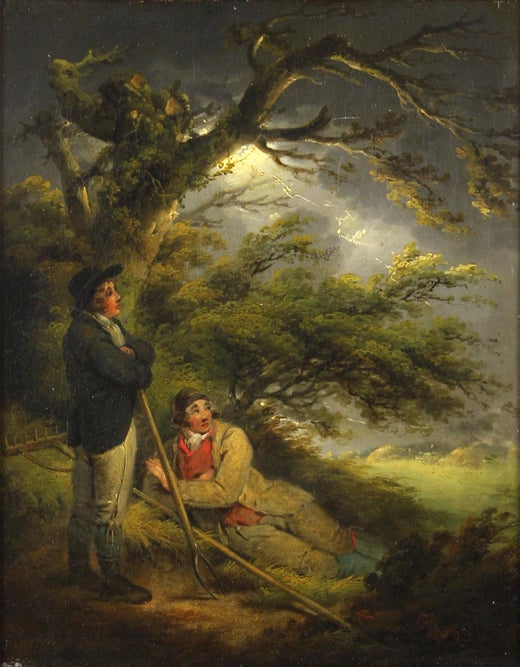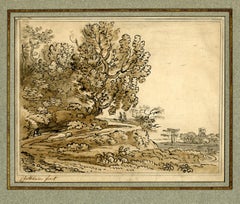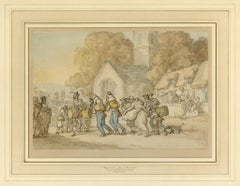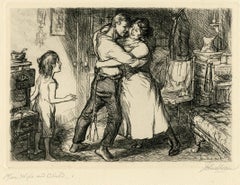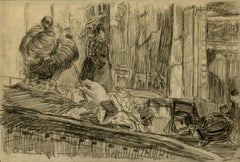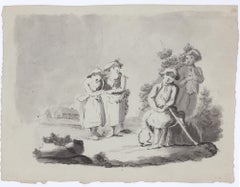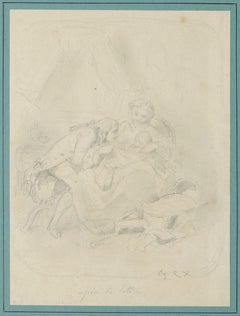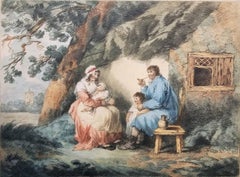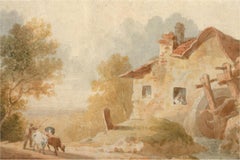Items Similar to Family Group
Want more images or videos?
Request additional images or videos from the seller
1 of 13
George MorlandFamily Group
$5,500
£4,147.55
€4,796.84
CA$7,716.47
A$8,577.34
CHF 4,496.06
MX$104,750.03
NOK 56,130.66
SEK 52,808.48
DKK 35,802.19
About the Item
Family Group
Drawing in Chinese white, sepia and bistre ink, c. 1790
Signed lower left: G. Morland (see photo)
The present work appears to be a preliminary study for two Morland paintings where the artist uses portions of this preliminary study in finished exhibition paintings. The strongest association is with the painting entitled The Cottage Door (1790), now in the collection of Royal Holloway College, University of London. Morland uses the same small girl (on left side of this sheet) holding a doll on a chair in the exact same pose. The second painting entitled The Tea Garden (Tate Gallery, London, c. 1790) incorporates similar poses and gestures of the three other figure studies on this sheet.
Provenance: Colnaghi, London (Stock # D25924, see photo)
Maynard Walker Gallery, New York ( see photo of label)
Davis Galleries, New York, their Eagle stamp and stock number (see photo)
Ms. Gloria Kaplan (1930-2011) New York City
Regarding Maynard Walker:
Maynard Walker New York Times obit:
"Maynard Walker, an art dealer in New York City for nearly 40 years who was among the first to show the works of leading American regionalist painters, died of pneumonia Tuesday at St. Joseph's Hospital in Carbondale, Pa. He was 89 years old and lived in Lake Ariel, Pa.
In 1933, while working at the Ferargil Gallery in New York, Mr. Walker organized an exhibition for the Kansas City Art Institute that for the first time brought together the work of the regionalist painters Grant Wood, Thomas Hart Benton and John Steuart Curry.
After Mr. Walker opened his own gallery, at 108 East 57th Street, in 1935, these artists joined him and showed regularly there. The gallery was also among the first to show the work of George Grosz, the German painter and caricaturist, who moved to the United States in 1932. The gallery moved to 117 East 57th Street after the war."
Condition: Aging to paper
Slight fading to ink
Tiny spotting in image
All consistent with the age of the drawing
Image size: 6 3/8 x 9 1/2 inches
Frame size: 14 1/4 x 17 1/4 inches
George Morland was born in London on 26 June 1763. He was the son of Henry Robert Morland, and grandson of George Henry Morland, said by Cunningham to have been lineally descended from Sir Samuel Morland, while other biographers go so far as to say that he had only to claim the baronetcy in order to get it. Morland began to draw at the age of three years, and at the age of ten (1773) his name appears as an honorary exhibitor of sketches at the Royal Academy. He continued to exhibit at the Free Society in 1775 and 1776, and at the Society of Artists in 1777, and then again at the Royal Academy in 1778, 1779 and 1780.
His talents were carefully cultivated by his father, who was accused of stimulating them unduly with a view to his own profit, shutting the child up in a garret to make drawings from pictures and casts for which he found a ready sale. The boy, on the other hand, is said to have soon found a way to make money for himself by hiding some of his drawings, and lowering them at nightfall out of his window to young accomplices, with whom he used to spend the proceeds in frolic and self-indulgence. It has been also asserted that his father, discovering this trick, tried to conciliate him by indulgence, humouring his whims and encouraging his low tastes.
He was set by his father to copy pictures of all kinds, but especially of the Dutch and Flemish masters. Among others he copied Fuseli's Nightmare and Reynolds's Garrick between Tragedy and Comedy. He was also introduced to Sir Joshua Reynolds, and obtained permission to copy his pictures, and all accounts agree that before he was seventeen he had obtained considerable reputation not only with his friends and the dealers, but among artists of repute. A convincing proof of the skill in original composition which he had then attained is the fine engraving.
It is said that before his apprenticeship to his father came to an end, in 1784, Romney offered to take him into his own house, with a salary of £300, on condition of his signing articles for three years. But Morland, we are told, had had enough of restraint, and after a rupture with his father he set up on his own account in 1784 or 1785 at the house of a picture dealer, and commenced that life which, in its combination of hard work and hard drinking, is almost without a parallel.
Morland soon became the mere slave of the dealer with whom he lived. His boon companions were "ostlers, potboys, horse jockeys, moneylenders, pawnbrokers, punks, and pugilists." In this company the handsome young artist swaggered, dressed in a green coat, with large yellow buttons, leather breeches, and top boots. "He was in the very extreme of foppish puppeyism", says Hassell; "his head, when ornamented according to his own taste, resembled a snowball, after the model of Tippey Bob, of dramatic memory, to which was attached a short, thick tail, not unlike a painter's brush." His youth and strong constitution enabled him to recover rapidly from his excesses, and he not only employed the intervals in painting, but at this time, or shortly afterwards, taught himself to play the violin. He made also an effort, and a successful one, to free himself from his task-master, and escaped to Margate, where he painted miniatures for a while. In 1785 he paid a short visit to France, whither his fame had preceded him, and where he had no lack of commissions.
Returning to London, he lodged in a house at Kensal Green, on the road to Harrow, near William Ward, intercourse with whose family seems for a time to have had a steadying influence. It resulted in his marriage with Miss Anne Ward (Nancy), the sister of his friend, in July 1786, and the bond between the families was strengthened a month later by the marriage of William Ward and Morland's sister Maria. The two newly married couples set up house together in High Street, Marylebone, and Morland for a while appeared to have become a reformed character.
He was now becoming known by such engravings from his pictures as the large 'Children Nutting' (1783), and several smaller and more sentimental subjects published in 1785, like the ' Lass of Livingston.' To 1786, the year of his marriage, is said to belong the series of 'Letitia or Seduction' (well known from the engravings published in 1789), in which with much of the narrative power of Hogarth, but with softer touches, the 'Progress' of Letitia is told in six scenes admirable in design, and painted with great skill, finish, and refinement. About this period he was fond of visiting the Isle of Wight, where he painted his best coast scenes, and studied life and character in a low public-house at Freshwater Gate, called the Cabin.[3] In 1786 he painted The Wreck of the Haswell, an oil on canvas. It shows women and children clutching what little of the ship remains afloat while a crewman's eyes tell the eventual fate of his half-submerged body. It clearly conveys the terror and hopelessness that must grip people when they know they're taking their last breath.
Later life
After three months the double household was broken up by dissensions between the ladies, and Morland took lodgings in Great Portland Street, and afterwards moved to Camden Town, where he lived in a small house in Pleasing Passage, at the back of the tavern known as Mother Black Cap. The attractions of the neighbouring inns, and of the Assembly Rooms at Kentish Town, now proved too strong for him, and he returned to all his bad habits. A long illness of his wife, following her confinement and death of the child, further weakened the influence of home, and he neglected and ultimately left his wife, though he seems to have made her an allowance as long as he lived.
When he finally separated from her it is not easy to determine, and his course afterwards was so erratic that it is difficult to trace it with minuteness and order. He moved from Pleasing Passage to Warrens Lane, and seems for some time to have made his headquarters at Paddington. It was here probably that he painted the celebrated picture of 'The Inside of a Stable,' now in the National Gallery, which was exhibited at the Royal Academy in 1791. The stable is said to be that of the White Lion Inn at Paddington, opposite to which he lived. At this time he was at the plenitude of his power, and dissipation had not impaired the sureness of his touch, his unusually fine sense of colour, or the refinement of his artistic feeling. He exhibited again in 1793 and 1794, but though he still painted finely he had become completely the prey of the dealers, painting as it were from hand to mouth to supply himself with funds for his extravagances.
His art was so popular that, comparatively small as was the price which he actually received for his labour, he might have easily lived for a week on the earnings of a day. He was besieged by dealers who came to him, as it is said, with a purse in one hand and a bottle in the other. The amount of work he got through was prodigious. He would paint one or two pictures a day, and once painted a large landscape with six figures in the course of six hours. Every demand that was made upon him, whether a tavern score or the renewal of a bill, was paid by a picture. And they were good pictures too, generally worth many times the value of the account to be settled, and always popular in engravings.
Career
From 1788 to 1792 inclusive, over a hundred engravings after Morland were published. They included 'A Visit to the Child at Home' and 'A Visit to the Boarding School,' two compositions of remarkable refinement and elegance, and a number of charming scenes of children's sports, like 'Children Birdnesting,' 'Juvenile Navigation,' 'The Kite entangled,' 'Blind Man's Buff,' and 'Children playing at Soldiers.' Equalling if not exceeding these in popularity were scenes of moral contrast, like 'The Fruits of early Industry and Economy' (1789) and 'The Effects of Extravagance and Idleness' (1794), the 'Miseries of Idleness' and the 'Comforts of Industry,' both published in 1790, and subjects appealing to national sentiment, like 'The Slave Trade' (1791) and 'African Hospitality.' Five hundred copies of the engraving of 'Dancing Dogs' (1790) were sold in a few weeks, and one dealer gave an order for nine dozen sets of the four plates of 'The Deserter' (1791). Elegant and refined subjects gradually gave place exclusively to scenes from humble life in town and country, including the coast with fishermen and smugglers, sporting scenes, but more frequently, in a plain but seldom a coarse manner, the life of the cottage, the stable, and the inn-yard, with lively groups of natural men and women, and still more natural horses, donkeys, dogs, pigs, poultry, and other animals. About 250 separate engravings from his works appeared in his lifetime.
Although the publishers reaped the benefits of their large sale, Morland's credit and resources enabled him for some years to lead the rollicking life he loved without much pressure of care. At one time he kept eight saddle horses at the White Lion. As time went on debts increased and creditors became more pressing, and he lived a hunted life, only able to escape from the bailiffs by his knowledge of London and the assistance of friends and dealers. He flitted from one house to another, residing among other places at Lambeth, East Sheen, Queen Anne Street, the Minories, Kensington, and Hackney. At Hackney his seclusion aroused the suspicion that he was a forger of bank notes, and his premises were searched at the instance of the bank directors, who afterwards made him a present of 40l. for the inconvenience caused by their mistake.
Dealers and innkeepers also would keep rooms ready for him to paint in, supplied with the necessary materials, and there was generally some dealer at hand ready to carry off his pictures before they were dry, often before they were finished. Morland was not, however, much more scrupulous in his dealings than the dealers themselves, and a picture begun under contract with one would be parted with to another who had money in his hand, if the rightful owner was not there to claim it. In this way a number of pictures got into the market commenced by Morland, and finished by inferior hands, while hundreds of copies were made and sold as originals. 'I once saw,' says Hassell, 'twelve copies from a small picture of Morland's at one time in a dealer's shop, with the original in the centre.' Another dealer (according to Redgrave), in whose house he painted under contract in the morning for several years (commencing about 1794), had each morning's work regularly copied. Occasionally Morland managed to escape from both dealers and bailiffs. Once he paid a visit to Claude Lorraine Smith in Leicestershire. He was apprehended as a spy at Yarmouth. He painted the sign of an inn called the Black Bull, somewhere on the road between Deal and London.
In November 1799, Morland was at last arrested for debt, but was allowed to take lodgings 'within the rules,' and these became the rendezvous of his most discreditable friends. During this mitigated confinement he sank lower and lower. He is said to have often been drunk for days together, and to have generally slept on the floor in a helpless condition. It is probable that these stories are exaggerated, for he still produced an enormous quantity of good work. 'For his brother alone,' says Redgrave, 'he painted 192 pictures between 1800 and 1804, and he probably painted as many more for other dealers during the same period, his terms being four guineas a day and his drink.' Another account says that 'during his last eight years he painted 490 pictures for his brother, and probably three hundred more for others, besides making hundreds of drawings. His total production is estimated at no less than four thousand pictures.
In 1802, he was released under the Insolvent Debtors Act, but his health was ruined and his habits irremediable. About this time he was seized with palsy and lost the use of his left hand, so that he could not hold his palette. Notwithstanding he seems to have gone on painting to the last, when he was arrested again for a publican's score, and died in a sponging-house in Eyre Street, Cold Bath Fields, on 27 October 1804. His wife died three days afterwards, and both were buried together in the burial-ground attached to St. James's Chapel in the Hampstead Road.
Works
Dogs In Landscape - Setters
The finest of Morland's pictures were executed between 1790 and 1794, and amongst them his picture The inside of a stable (Tate Britain, London) may be reckoned as a masterpiece. In the last eight years of his life Morland produced some nine hundred paintings, besides over a thousand drawings.
He exhibited regularly at the Royal Academy from 1784 down to 1804. Amongst these was the remarkable 1788 picture Execrable Human Traffic or the Affectionate Slaves. Two years later he exhibited a companion picture showing Africans caring for shipwrecked Europeans. They were subsequently published as prints and served to promote abolitionism.
Morland was a close friend of fellow artist William Armfield Hobday (1771–1831) who painted a portrait of the artist which is still intact. William Collins was an informal pupil and later wrote a biography.
Courtesy Wikipedia
- Creator:George Morland (1763 - 1804, English)
- Dimensions:Height: 6.38 in (16.21 cm)Width: 9.5 in (24.13 cm)
- Medium:
- Movement & Style:
- Period:1790-1799
- Condition:
- Gallery Location:Fairlawn, OH
- Reference Number:Seller: FA81381stDibs: LU14016133392
George Morland
George Morland (26 June 1763 in London – 29 October 1804 in Brighton) was an English painter. His early work was influenced by Francis Wheatley but after the 1790s he came into his own style. His best compositions focus on rustic scenes: farms and hunting; smugglers and gypsies; and rich, textured landscapes informed by Dutch Golden Age painting.
About the Seller
5.0
Recognized Seller
These prestigious sellers are industry leaders and represent the highest echelon for item quality and design.
Platinum Seller
Premium sellers with a 4.7+ rating and 24-hour response times
Established in 1978
1stDibs seller since 2013
808 sales on 1stDibs
Typical response time: <1 hour
Associations
International Fine Print Dealers Association
- ShippingRetrieving quote...Shipping from: Fairlawn, OH
- Return Policy
Authenticity Guarantee
In the unlikely event there’s an issue with an item’s authenticity, contact us within 1 year for a full refund. DetailsMoney-Back Guarantee
If your item is not as described, is damaged in transit, or does not arrive, contact us within 7 days for a full refund. Details24-Hour Cancellation
You have a 24-hour grace period in which to reconsider your purchase, with no questions asked.Vetted Professional Sellers
Our world-class sellers must adhere to strict standards for service and quality, maintaining the integrity of our listings.Price-Match Guarantee
If you find that a seller listed the same item for a lower price elsewhere, we’ll match it.Trusted Global Delivery
Our best-in-class carrier network provides specialized shipping options worldwide, including custom delivery.More From This Seller
View AllLandscape with Figures in the English Countryside
Located in Fairlawn, OH
Landscape with Figures in the English Countryside
Pen, ink and graphite with gray and brown washes on laid watermarked paper, c. 1740
Signed by the artist lower left of image: "Chate...
Category
1740s Romantic Landscape Drawings and Watercolors
Materials
Ink
Recruits on a March
By Thomas Rowlandson
Located in Fairlawn, OH
Recruits on a March
Ink and watercolor on paper, mounted on support
Unsigned
Condition: watercolor sheet laid down on paper, moderately faded
Original Ackermann frame and matting
Ima...
Category
Early 1800s Romantic Figurative Drawings and Watercolors
Materials
Watercolor
Man, Wife and Child
By John French Sloan
Located in Fairlawn, OH
Man, Wife and Child
Etching, 1905
Signed and titled in pencil by the artist below image (see photo)
Annotated in pencil by the artist "100 proofs"
Signed and dated in the plate lower...
Category
Early 1900s Ashcan School Figurative Prints
Materials
Etching
Loge de Theatre (Preliminary study for a painting)
By Charles Dufresne
Located in Fairlawn, OH
Loge de Theatre (Preliminary study for a painting)
Graphite on paper
Signed in pencil lower left
Annotated with color notations by the artist (see photo)
A early Parisian theme work ...
Category
1910s Impressionist Interior Drawings and Watercolors
Materials
Graphite
The Forge
By James Abbott McNeill Whistler
Located in Fairlawn, OH
The Forge
Drypoint, 1861
Signed in the plate lower right (see photo)
Published as part of the Thames Set, 1871
Printed between 1894 and 1896 when the plate was canceled. This impress...
Category
1860s Impressionist Figurative Prints
Materials
Drypoint
A Cart Race
By Thomas Rowlandson
Located in Fairlawn, OH
A Cart Race
Hand colored etching & aquatint, 1788
Signed in the plate (see photo)
Published by William Hollande, London
Inscribed in the plate with title, artist's name and publication line 'Rowlandson. 1788./ London. Pubd 1789 by Wm Holland No 50. Oxford Street.'
Reference: M.Dorothy George, 'Catalogue of Political and Personal Satires in the British Museum', VI, 1938)
British Museum Satires 7607
Grego, 'Rowlandson', i. 260, Grego II.392
Provenance: Chris Beetles Ltd., London (label), 2003
Jeffrey M. Kaplan, Washington, D.C.
(label)
Fursten zu Oettingen-Wallerstein, Lugt 2715a,
verso (see photo)
Condition: Excellent
Printed on 18th century laid paper
Archival framing by Chris Beetles Ltd., London
Note: The British Museum has two impressions, one trimmed the other full sheet as this example. Accession Number: 1868,0711.35
The Metropolitan Museum has an impression: Accession number 59.533.314
Fitzwilliam Museum: Accession number: 34.14-286
Cleveland Museum of Art accession number: 1958.10
Image description per BM: Three ramshackle two-wheeled carts drawn by wretched horses race (right to left) against a background formed by the church...
Note: The British Museum has two impressions, one trimmed the other full sheet as this example. Accession Number: 1868,0711.35
The Metropolitan Museum has an impression: Accession number 59.533.314
Fitzwilliam Museum: Accession number: 34.14-286
Cleveland Museum of Art accession number: 1958.10
Image description per BM: Three ramshackle two-wheeled carts drawn by wretched horses race (right to left) against a background formed by the clouds of dust which they have raised, with a row of gabled houses (right) inscribed 'St Giles', terminating in a church spire (left), and probably representing Broad St. Giles. The occupants of the carts are Irish costermongers typical of St. Giles. The foremost horse gallops, urged on by the shouts of a standing man brandishing a club. The other occupants, two women and a man, cheer derisively the next cart, whose horse has fallen, one woman falling from it head-first, another lies on the ground. The driver lashes the horse furiously. The third cart, of heavier construction, is starting. The horses are partly obscured by the clouds of dust, but denizens watch from casement windows and a door. Two ragged urchins (right) cheer the race; a dog barks.
"It was said that the amount of copper Thomas Rowlandson etched would sheathe the British Navy. An inveterate gambler, for much of his life Rowlandson had to produce a flood of his comic prints to stay ahead of financial losses.A wealthy uncle and aunt raised Rowlandson after his textile-merchant father went bankrupt. His career developed quickly. He entered London's Royal Academy Schools in 1772, visited Paris in 1774, exhibited at the Royal Academy in 1775, and won a silver medal in 1777. He left school in 1778 to set up in business. Rowlandson's depictions of life in Georgian England exposed human foibles and vanity with sympathy and rollicking humor. During the 1780s he consolidated the delicate style he used for his coarse subjects. He worked mainly in ink and watercolor, his rhythmic compositions, flowing line, and relaxed elegance inspired by French Rococo art...
Category
1780s Romantic Figurative Prints
Materials
Aquatint
You May Also Like
The Introduction, French School, 18th century
Located in Middletown, NY
In this charming scene a maid appears bashful as she is introduced by her mother to the shepherd’s son.
Ink and wash on hand made, cool-toned cream laid paper, 6 3/4 x 8 7/8 inches...
Category
Mid-18th Century French School Figurative Drawings and Watercolors
Materials
Ink, Watercolor, Handmade Paper, Laid Paper
Family Portrait - Pencil - Early 19th Century
Located in Roma, IT
Family Portrait is an artwork realized by an artist of the early 19th Century.
Pencil drawing paper pasted on cardboard annotated "after the letter" signed Comp… .Cal…. "Paris 2/5/...
Category
Early 20th Century Modern Figurative Drawings and Watercolors
Materials
Pencil
A Rustic Family /// George Morland British Figures Cottage Landscape Etching Art
By George Morland
Located in Saint Augustine, FL
Artist: (after) George Morland (English, 1763-1804)
Title: "A Rustic Family"
Portfolio: Original Sketches from Nature by Various Masters
*Signed by Morland in the plate (printed sign...
Category
1790s Victorian Figurative Prints
Materials
Etching, Intaglio
Follower of George Morland (1762-1804)-Early 19thC Watercolour, Returning Cattle
Located in Corsham, GB
A fine bucolic watercolour showing a farmer, driving home two bulls towards and old watermill. The artist has captured beautifully idyllic light that illumin...
Category
19th Century Landscape Drawings and Watercolors
Materials
Watercolor
18th Century French Oil Painting Tavern Scene Interior Merry Making Figures
Located in Cirencester, Gloucestershire
Merry Makers in the Tavern
French School, 18th century
oil on canvas
canvas: 8 x 11 inches
provenance: private collection, France
condition: good and sound condition
Category
18th Century Old Masters Figurative Paintings
Materials
Oil, Canvas
$960 Sale Price
30% Off
France 18th Century, The Surprised Lovers, original drawing
Located in Paris, FR
France circa 1770
Two lovers surprised in bed
Black chalk on paper
13 x 17 cm
Modern frame : 34 x 38 cm
This drawing had been attributed to Gabriel de Saint Aubin (1724-1780). It's...
Category
1760s Old Masters Interior Drawings and Watercolors
Materials
Chalk
More Ways To Browse
Family Photo
Groups Of Women Paintings
Antique Directors Chair
Ladies Antique Chair
Antique Childrens High Chair
French Garden Drawings
Lion Drawing
George Holland
Royal Art Lodge
Dior Photo Frame
Thomas Downing Artist
Joseph Collins
Dancer Figure Drawing
Drawings Of Dogs
Antique Picture Frames London
Sepia Drawing
Antique School Doors
Boy George
